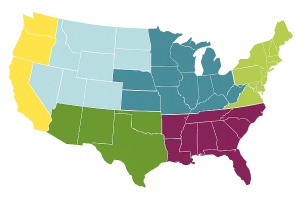Iowa Native Plants, State Flower & State Bird
Posted By American Meadows Content Team on Sep 27, 2012 · Revised on Oct 26, 2025

Knowing your location helps us recommend plants that will thrive in your climate, based on your Growing Zone.
Posted By American Meadows Content Team on Sep 27, 2012 · Revised on Oct 26, 2025
Native plants are adaptable, low-maintenance, and beautiful. They are the best choice for habitat-friendly gardens and thriving ecosystems. Find top picks for native plants in your state - and learn about your state bird and state flowers!
Follow Along With More Of Our Guides
Hello native plant enthusiasts! In the list below, you will find popular native plants and wildflower seeds, available from American Meadows, that have a native distribution in your state. You’ll also find information about your state bird, state flower, and state wildflower!
Grow our Native Midwest Wildflower Seed Mix
Virginia Bluebells (Mertensia virginica)
Showy Goldenrod (Solidago speciosa)
Perennial Lupine (Lupinus perennis)
Black Eyed Susan or Gloriosa Daisy (Rudbeckia hirta)
Purple Coneflower (Echinacea purpurea)
Pale Purple Coneflower (Echinacea pallida)
Yellow Prairie Coneflower (Ratibida columnifera)
Gray Headed Coneflower (Ratibida pinnata)
Butterfly Weed (Asclepias tuberosa)
Swamp Milkweed (Asclepias incarnata)
Common Milkweed (Asclepias syriaca)
Long Beaked Sedge (Carex sprengelii)
White Tinged Sedge (Carex albicans)
Wild Strawberry (Fragaria virginiana)
Plains Coreopsis (Coreopsis tinctoria)
Lanceleaf Coreopsis (Coreopsis lanceolata)
Wild Bergamot (Monarda fistulosa)
Wild Geranium (Geranium maculatum)
Elderberry (Sambucus canadensis)
Phlox divaricata (Woodland Phlox)
Phlox subulata (Creeping Phlox)
Obedient Plant (Physostegia virginiana)
Red Cardinal Flower (Lobelia cardinalis)
Prairie Blazing Star (Liatris pycnostachya)
Meadow Anemone (Anemone canadensis)
Anise Hyssop (Agastache foeniculum)
Bottlebrush Grass (Elymus hystrix)
Muhly Grass (Muhlenbergia capillaris)
Big Bluestem (Andropogon gerardii)
Little Bluestem (Schizachyrium scoparium)
Tufted Hair Grass (Deschampsia cespitosa)
Northern Sea Oats (Chasmanthium latifolium)
Yellow Prairie Grass (Sorghastrum nutans)
Smooth Blue Aster (Symphyotrichum laeve)
Aromatic Aster (Symphyotrichum oblongifolium)
New England Aster (Symphyotrichum novae-angliae)
Sky Blue Aster (Symphyotrichum oolentangiense)
Ironweed (Vernonia fasciculata)
Common White Yarrow (Achillea millefolium)
Heliopsis (Heliopsis helianthoides)
Purple Prairie Clover (Dalea purpurea)

Eastern Goldfinch ~ Spinus tristis
Many people enter into the spirit of summer when they finally hear the ecstatic bursts of song from the Eastern Goldfinch. This lively bird, also known as the wild Canary or Yellowbird, sails through the air on an ocean of joy. In summer, when the thistles reach full bloom, mating season begins. The thistledown is used by mated pairs for nest building, and the plant also provides a favorite food as its seeds are usually ripe when the young Goldfinch needs them most.
Wild Rose ~ Rosa blanda
The Wild Rose of Iowa has five petals, which close protectively over the many stamens on rainy days and at night. Roses have no nectar, but they have pollen which attracts many insects. After the petals fall, the green seed receptacles, each with a crown of five sepals, swell and grow. In the winter the bright red color of these berries, or hips, is most noticeable. Practical uses of Roses, besides their importance as a source of perfume, include a delicate-flavored and delicious jelly made from the Rose hips of some Wild Rose species.
From The Wildflowers of the 50 States U.S. stamps issues July 24, 1992:

